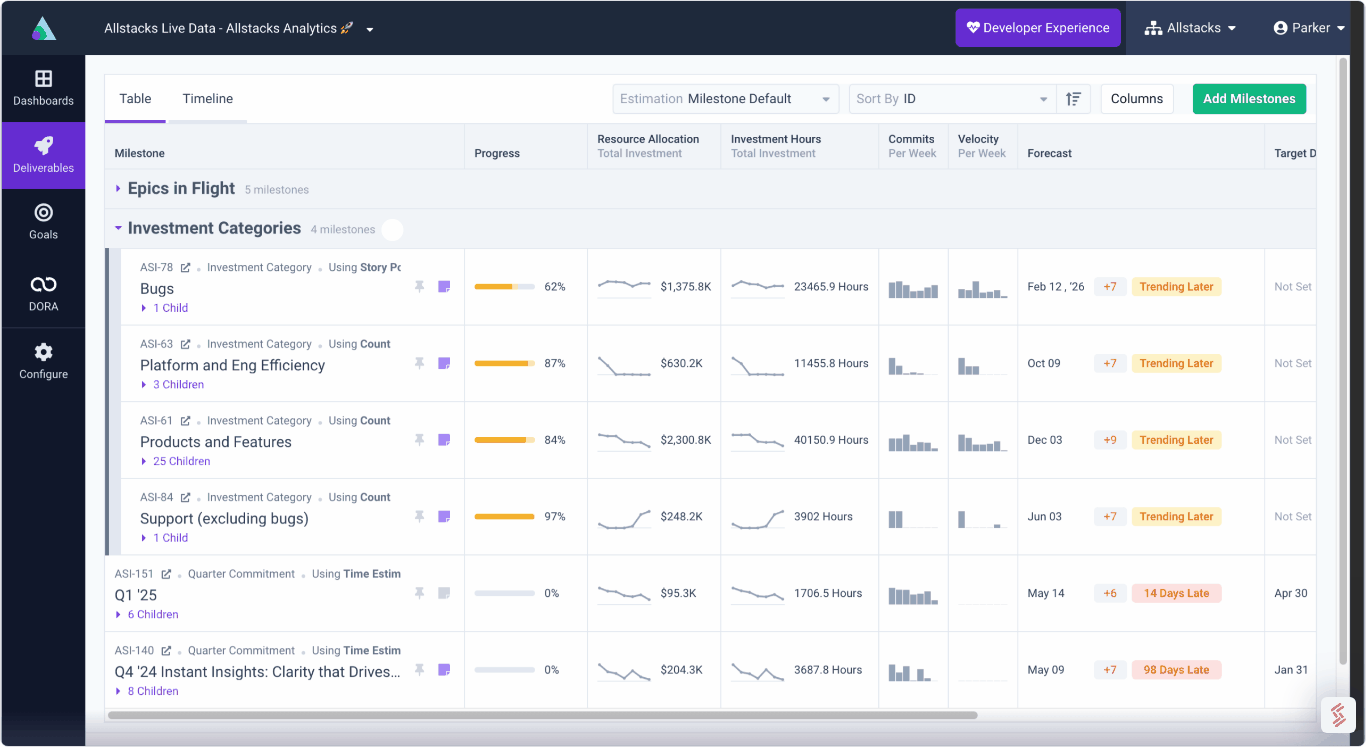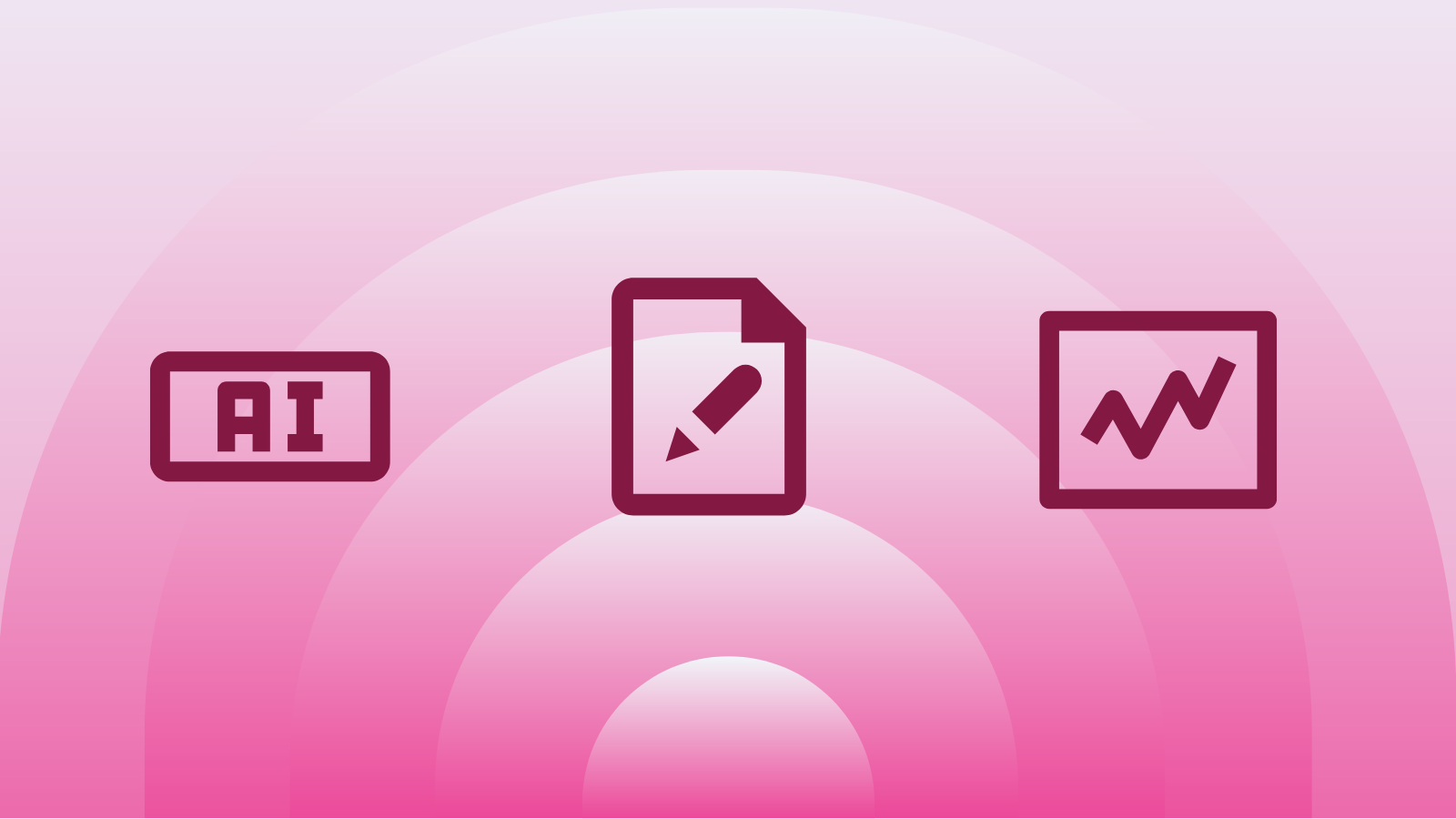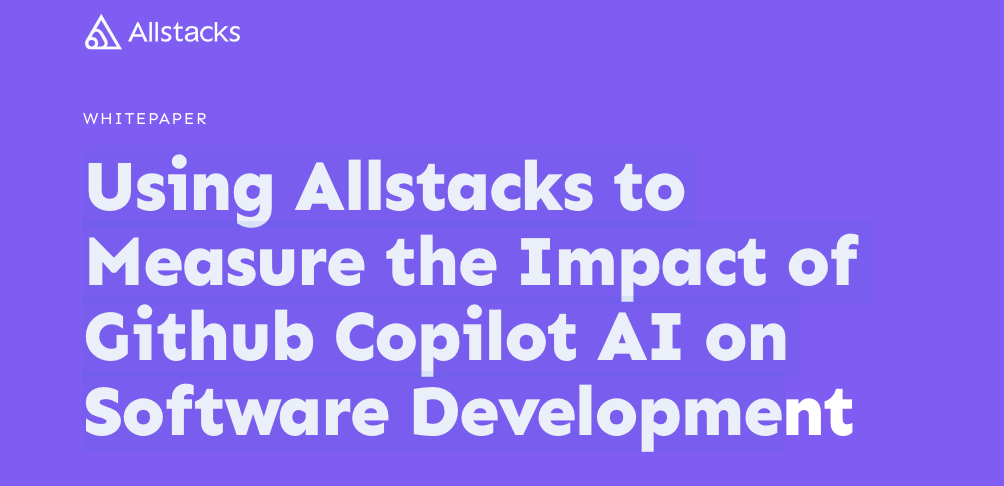.png)
Software Engineering Intelligence
-
Intelligence Engine
On-demand exhaustive AI-analysis
-
Engineering Investment
Complete visibility into time & dollars spent
-
360º Insights
Create meaningful reports and dashboards
-
Project Forecasting
Track and forecast all deliverables
DevEx
-
Developer Surveys
Create and share developer surveys
Software Capitalization
-
R&D Capitalization Reporting
Align and track development costs
Weaving Agents Into the Developer's Flow
Why the future of development lies in knowing what to offload (and what to keep).
With all the excitement around agentic development, there's an underlying assumption that we'll simply replace certain development tasks with AI agents. But this misses a crucial reality: development isn't a collection of discrete, independent tasks that can be easily swapped out. It's a fluid, non-linear problem-solving journey where the real challenge lies not in sequential handoffs, but in understanding how to offload entire blocks of work while keeping developer focus trained on the hard, yet-to-be-automated problems.
Today, all development work is performed essentially the same way—by humans, using human approaches, at human speed. But as agents become more capable, the real competitive advantage will come from mastering the art of offloading: knowing which chunks of work can be delegated entirely, while maintaining focus on the complex problem-solving that still requires human insight.
"The future of development isn't about perfect handoffs—it's about strategic offloading while keeping human attention where it matters most."
The Bouncing Reality: Building a Simple Feature
Let's trace through what it actually looks like to build something seemingly straightforward—adding a "favorite" button to a product listing page. Watch how a developer's attention bounces between different levels of thinking and different types of problems:
9:15 AM - Start with the request: Product wants users to favorite items. Simple enough, right? But wait—do favorites sync across devices? Are they public or private? Do we show favorite counts? How do favorites impact recommendations? Five minutes of Slack messages with the product manager.
9:23 AM - Database design: Okay, we need a user_favorites table. But hold on—our current user table design assumes one account per person, but the mobile team mentioned shared family accounts. And what about guest users who later create accounts? Quick database schema review, then a mental note to check with the mobile team later.
9:31 AM - API design: RESTful? GraphQL mutation? Batch operations for multiple favorites? What about rate limiting—users could spam favorite/unfavorite. Sketching out API endpoints while simultaneously considering caching implications.
9:38 AM - Front-end state management: Where does favorite state live? Redux? Local component state? What happens when favorites change on another device? Do we need real-time updates? Mental context switch to UI patterns and state synchronization.
9:45 AM - Back to business logic: Actually, how do favorites interact with our existing recommendation engine? If someone favorites 20 horror movies, should we stop showing them comedies? This could impact the core product experience. Another Slack conversation, this time with the data science team.
9:52 AM - Security considerations: Can users favorite any product, or just ones they have access to? What about deleted products? Private products? Admin-only products? Quick security model review.
9:58 AM - Implementation planning: Okay, let's start coding. Database migration first, then API endpoints, then... wait, we should probably feature flag this. And we'll need analytics events. And error handling for when the favorites service is down. Mental shift to operational concerns.
10:05 AM - Actually coding: Finally writing the database migration. But the existing schema uses UUIDs and this feels like it should use auto-incrementing IDs for performance. Quick research on UUID vs. integer performance for high-volume tables.
10:15 AM - Context switch: Slack notification—the mobile team says shared accounts are definitely coming next quarter. Back to the drawing board on the data model. Revising the database design to accommodate future requirements.
10:23 AM - API implementation: Writing the endpoints, but now thinking about backwards compatibility. If we change the schema later, these endpoints need to keep working. Designing API responses with extensibility in mind.
10:31 AM - Front-end integration: Building the favorite button component. Should it be a heart? A star? How does it animate? What's the loading state? Error state? Visual design decisions while implementing interaction logic.
10:38 AM - Testing considerations: Unit tests for the API, but also integration tests for the full flow. What about edge cases—favoriting an item that gets deleted while the request is in flight? Writing test cases while thinking through failure scenarios.
10:45 AM - Performance review: Wait, this adds a database join to every product listing query. With thousands of products per page, this could be slow. Maybe we need a separate favorites check API? Architecture reconsideration based on performance implications.
10:52 AM - Documentation: Future developers (including future me) need to understand how this works. But the requirements changed three times already, so what do I document? Balancing comprehensive documentation with evolving requirements.
And this is just the first two hours of what seemed like a simple feature. The developer's attention constantly bounces between business logic, technical architecture, user experience, performance, security, future maintainability, and operational concerns. Each context switch requires loading different mental models and considering different constraints.
The Offloading Opportunity
Here's where the agent opportunity becomes clear: many of these bounces involve work that could be offloaded entirely, freeing the developer to maintain focus on the complex, interconnected decisions.
What could be offloaded:
- Writing the actual database migration code once the schema is designed
- Generating boilerplate API endpoints once the interface is defined
- Creating standard CRUD operations and validation logic
- Writing comprehensive unit tests once the business logic is clarified
- Generating documentation for straightforward functionality
- Implementing standard UI components once the behavior is specified
What requires human focus:
- Understanding the business context and implications
- Making architectural decisions that balance current needs with future flexibility
- Designing APIs that will remain stable as requirements evolve
- Considering security and performance implications
- Thinking through edge cases and failure scenarios
- Coordinating with other teams and systems
The power isn't in perfect handoffs between human and agent work—it's in being able to offload entire blocks of implementation work so the developer can maintain cognitive focus on the hard problems that require deep technical judgment and business understanding.
The Cognitive Load Problem
The real challenge in development isn't writing code—it's managing cognitive load while juggling multiple complex, interconnected decisions. Every context switch has a cost. Every time you shift from high-level architecture thinking to detailed implementation, you lose some of the broader context you were holding in your head.
Agents can help by taking over the entire implementation of well-defined blocks of work, allowing developers to stay focused on the architecture, the business logic, the integration challenges, and the strategic decisions. The goal isn't collaboration on every task—it's strategic delegation of entire chunks of work.
But this requires a different skill set than traditional development. You need to become excellent at:
- Breaking complex problems into well-bounded blocks that can be offloaded
- Defining clear specifications and success criteria for agent work
- Designing interfaces and contracts that remain stable even as implementation details change
- Recognizing which decisions require human judgment and which can be automated
Why Developers Become More Critical, Not Less
This offloading capability actually makes experienced developers more valuable, not less. The ability to see the big picture, understand the interconnections between different parts of the system, and make strategic technical decisions becomes the primary differentiator.
Junior developers often get stuck in implementation details—writing code becomes the primary challenge. But senior developers spend most of their time on exactly the kinds of problems that can't be easily automated: understanding business context, making architectural trade-offs, designing for future flexibility, and coordinating across teams and systems.
As agents become better at implementation, the premium on this higher-level technical judgment increases. The developers who can maintain focus on the strategic challenges while effectively offloading the tactical work will be dramatically more productive than those who try to do everything themselves.
The Unsolved Challenge
We're still figuring out how to do this effectively. The tools are evolving rapidly, but we don't have established patterns for:
- How to break down complex features into offloadable blocks
- What level of specification agents need to produce high-quality work
- How to maintain architectural coherence across agent-generated code
- When to invest time in detailed specifications vs. just doing the work yourself
Every team is experimenting with different approaches. Some are using agents for initial scaffolding, others for testing and documentation, still others for specific types of implementation work. New tools emerge daily that tackle different aspects of this challenge.
But we're all learning together. The teams that figure out effective patterns for strategic offloading will have a massive advantage—not because they can eliminate developers, but because they can amplify what skilled developers can accomplish.
The Path Forward
The conversation about AI replacing developers fundamentally misunderstands the nature of development work. The bouncing, non-linear, context-switching reality of building software requires someone who can hold the big picture while making detailed technical decisions. That's not going away—it's becoming more important.
What's changing is that the implementation work—the actual typing of code—is becoming less of a bottleneck. The constraint is shifting to problem understanding, architectural thinking, and strategic decision-making. These are fundamentally human skills that require technical depth, business understanding, and the ability to navigate ambiguity.
The future belongs to developers who can master the art of strategic offloading: knowing which blocks of work to delegate, how to specify them clearly, and how to maintain focus on the problems that truly require human insight. This isn't about working with agents—it's about amplifying human capabilities by removing the routine cognitive load.
We're writing the playbook as we go, and that's exactly what makes this moment so exciting. The teams that figure this out first won't just be more productive—they'll be solving fundamentally different problems than everyone else.




.png)